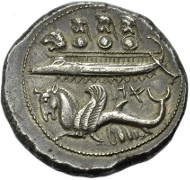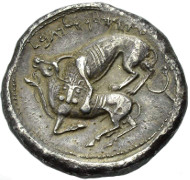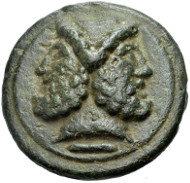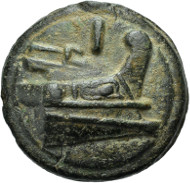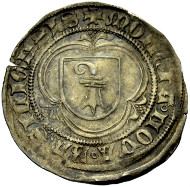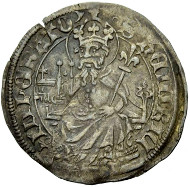03-06-2014 – 01-01-1970
Auction 40
Ancient Rarities and an Old Basel Collection.
Münzen & Medaillen GmbH, based in Weil am Rhein, Germany, will hold their fortieth auction sale on Wednesday, 4th June 2014 in Stuttgart. This promises to be an especially interesting sale as there will be a fine selection of ancient Greek coins on offer, as well as other ancient coins and, amongst the medieval and modern coins, an attractive selection of rarities from the city of Basel.
A particular highlight among the ancient coins is the Dekadrachmon from Syracuse in Sicily (Lot No. 102). Dating from a period in which certain coin engravers are, unusually for the ancient world, known to us by name, the coin can be attributed to Euainetos as its obverse die is identical to that of a Dekadrachmon in the collection of the American Numismatic Society on which his signature can be seen. Portraying a gallopping quadriga on one face and the head of the Nymph Arethusa on the other, this coin is an outstanding product of the flourishing artistic milieu in Syracuse at the end of the fifth and beginning of the fourth centuries before Christ. Our auction sale includes a number of other coins from Sicily, including two Syracusan Tetradrachms of a slightly earlier date (Lots No. 97 and 98). Whereas the coins from Syracuse portray the head of Arethusa encircled by four dolphins, the coins of Leontinoi depict a lion’s head as a ‘speaking badge’, surrounded by four cereal grains – a tribute to the fertility of the fields in the region. This coin too (Lot No. 85) is minted with the same dies as a coin in the ANS collection. Also noteworthy are two tetradrachms from Gela from old collections, depicting the protome of the river god Gelas as a man-headed bull (Nos. 76-77).
There are many other fine ancient Greek coins in the sale, including a rare stater minted by the Letai, a tribe in Macedonia / Thrace about whom little is known. On this coin, which depicts a Satyr carrying off a Nymph (who does not seem at all worried by the situation), the name of the tribe can be seen on the upper left of the flan (Lot No. 133).
Amongst the selection of Athenian coins is an extremely well preserved archaic Tetradrachmon, which comes from the renowned Asyut Hoard. After the owls comes a veritable menagerie of coins with turtles, flying Pegasi, coins of the fabled King Croesus depicting a lion and a bull, and an elephant Quadriga (No. 285). Seleucus I., founder of the Seleucid dynasty in Syria, employed war elephants which were bred on a special farm in Apameia.
No. 291 PHOENICIA, BYBLOS. Azbaal, 400-476 B. C. Shekel. SNG Cop. 132. Extremely fine. 3,800 Euros.
Also very attractive is the Shekel of the Phoenician King Azbaal of Byblos. It depicts a ship with a lion-head prow sailing over a Hippocamp, a huge sea monster (No. 291).
Especially eye-catching amongst the Greek coinage minted under Roman domination is the bronze from Abydos in the Troad minted under Severus Alexander. It depicts the myth of the lovers Hero and Leander: Hero lived in Sestos, Leander on the opposite bank of the Hellespont in Abydos, and as depicted on the coin Leander would swim over to her every night, here – helpfully – depicted with a torch-carrying Eros to guide him (Lot No. 354). The same scene is also depicted on a smaller bronze of Septimius Severus (Lot No. 350).
No. 450 AES GRAVE, ROME. Liberal Series. As, 225-217 B.C. Haeberlin plate 15,9. Extremely fine. 2,500 Euros.
The Roman section opens with a collection of aes grave, the large bronze proto-coinage used in early Italy. Conceived more as a convenient means of storing metal for barter than as a ‘coinage’ as we know it today, the pieces are extremely rare. Notable types include the double Janus heads (see No. 450), cockle shells (Nos. 428-430) and Athena heads – but bulls, chickens, turtles, knucklebones and acorns are also among the depictions! With nearly fifty examples in our sale this is a good opportunity to purchase pieces from a collection which has been put together over many years. Later coins from Rome include Republican Denarii: notable amongst these are the Denarius of Q. Caepio Brutus depicting the head of Libertas and his ancestor the tyrant-slayer L. Junius Brutus on the reverse (No. 516). Caesar is represented by a Denarius on which he plays on his family’s ancestral link to the Goddess Venus and the Trojan hero Aeneas – myths which were to play a defining role under his great-nephew Augustus (No. 521). The Roman section also contains Denarii of Tiberius, Galba and Otho. An interesting example of coin re-use is to be found in the As of Galba which was revalued under the Ostrogoths by means of an incised inscription to produce a denomination of 42 Nummia (No. 643).
The Celtic World is represented by a range of coins from Britain, Spain, France and Eastern Europe, comprising powerful, abstracted (and sometimes humorous!) reworkings of Classical images such as the imitations of Thasos and Philipp II. as well as coins in the unmistakable style of the tribes of the Catuvellauni and Durotriges of Britain (Nos. 368-372), or the Coriosolites of Armorica in Northern France (Lots 386-389).
The Byzantine section of our sale comprises a collection of bronze, silver and gold coins from Anastasius I and Justinian through to gold Histamenoi of Constantinos IX and Michael VII Dukas. The gold coins in particular are in a fantastic state of preservation. There is also a very fine lead seal of Alexios I Komnenos (Lot No. 639) and a wide selection of bronze issues.
No. 923 BASEL. Plappart, after the treaty of 1425. The city shield in a trefoil. Rv. The Holy Roman Emperor Heinrich seated on a Gothic throne, holding a model of the church and a lily scepter. Ewig 474 (this coin). Good very fine. 10,000 Euros.
The most notable part of the Medieval and Modern section of the sale is the collection of Basel coinage. Originating from an old private collection, the section includes rare medieval pennies from the early bishops and a very rare piefort of a Rappen-Vierer from ca. 1500 from the Ewig Collection (No. 927). Also rare and Ex-Ewig Collection is a Plappart minted after 1425 and depicting the Holy Roman Emperor Heinrich II. holding a model of the Minster (Lot No. 923). The emperor had supported Basel through generous donations and was held in particular honour there, where statues of him can still be seen on the Minster and the Town Hall.
No. 942 BASEL. Undated Thaler (about 1710), die cut by J. de Beyer. Ewig 191. Uncirculated. 1,500 Euros.
The Basel coinage includes many pieces depicting the Baselstab, the symbol of the city- whether combined with the double-headed eagle of the German Empire and the shields of arms of the nearby towns on the double Thalers of ca. 1640 (Lots No. 937 and 938), in an ornamental cartouche on the Doppelgoldgulden of ca. 1720 (Lot 943), or held by the Basilisk, whose name was linked through false etymology to that of the city (e.g. No. 944). There are also a number of Halbthaler and Thaler depicting views of the city of Basel (e.g. 940-942), a theme also found on medals and school prizes in gold and silver. Also included here is an interesting collection of cast copies of the seals of municipal and ecclesiastical institutions in Basel as well as those of private individuals (No. 956). The Basel coins form the main part of a section including coins from other parts of Switzerland, such as a wonderfully preserved Neutaler (4 Franken) test piece of the Helvetian Republic from 1799 (No. 962).
The auction ends with a sale of numismatic books, with many rarities and a particularly wide selection of works on ancient coins.
If you want to learn more about the moving love story of Heros and Leander as depicted on Roman Imperial coins offered in this auction don’t miss this edition’s article of the week!
The catalogue can be viewed on the internet.
The printed catalogue can be obtained by sending 10 Euros to Münzen & Medaillen GmbH, Hauptstrasse 175a, D-79539, Weil am Rhein, Germany.




